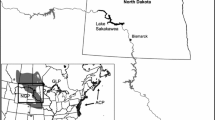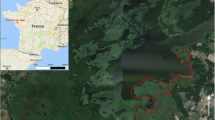Abstract
Habitat use of breeding diving ducks is not well-documented. I studied nesting and brood-rearing female redheads (Aythya americana) in southwestern Manitoba during 1994 and 1995 to document habitat use and associations between wetland characteristics and reproductive success. Most females nested in small, semi-permanent wetlands and were successful in wetlands with large bands of emergent cover. Success was associated with water depth at the nest and distance between the nest and dry land. Brood-rearing females switched from smaller wetlands used for nesting to larger, semi-permanent wetlands. Successful females selected appropriate habitat whereas unsuccessful females showed no preferences. These results support a landscape approach to wetland management and emphasize the need for plans that reduce impact to wetland margins.
Similar content being viewed by others
Literature cited
Ball, J. P. and T. D. Nudds. 1989. Mallard habitat selection: an experiment and implications for management. p. 659–671. In R. R. Sharitz and J. W. Gibbons (eds.) Freshwater Wetlands and Wildlife. U.S. Department Energy, National Technical Information Service, Springfield, VA, USA. Report DE90005384.
Clark, R. G. and T. D. Nudds. 1991. Habitat patch size and duck nesting success: the crucial experiments have not been performed. Wildlife Society Bulletin 19:534–543.
Crabtree, R. L., L. S. Broome, and M. L. Wolfe. 1989. Effects of habitat characteristics on gadwall nest predation and nest-site selection. Journal Wildlife Management 53:129–137.
Duebbert, H. F. and A. M. Frank. 1984. Value of prairie wetlands to duck broods. Wildlife Society Bulletin 12:27–34.
Dwernychuk, L. W. and D. A. Boag. 1972. How vegetative cover protects duck nests from egg-eating birds. Journal Wildlife Management 36:955–958.
Dzus, E. H. 1995. Survival and recruitment of mallards in relation to brood size, hatching date and wetland characteristics. Ph.D. Dissertation. University of Saskatchewan, Saskatoon, Saskatchewan, Canada.
Featherstone, J. D. 1975. Aspects of nest site selection in three species of ducks. Ph.D. Dissertation. University of Toronto, Toronto, Ontario, Canada.
Hines, J. E. and G. J. Mitchell. 1983. Gadwall nest-site selection and nesting success. Journal Wildlife Management 47:1063–1071.
Johnson, D. H. and A. B. Sargeant. 1977. Impact of red fox predation on the sex ratio of prairie mallards. U.S. Fish and Wildlife Service, Washington, DC, USA. Wildlife Resource Report 6.
Jones, R. E. and K. E. Hungerford. 1972. Evaluation of nesting cover as protection from magpie predation. Journal Wildlife Management 36:727–732.
Kaminiski, R. M. and M. W. Weller. 1992. Breeding habitats of nearetic waterfowl. p. 568–589. In B. D. J. Batt, A. D. Afton, M. G. Anderson, C. D. Ankney, D. H. Johnson, J. A. Kadlec, and G. L. Krapu (eds.) Ecology and Management of Breeding Waterfowl. University of Minnesota Press. Minneapolis, MN, USA.
Kantrud, H. A. and R. E. Stewart. 1977. Use of natural basin wetlands by breeding waterfowl in North Dakota. Journal of Wildlife Management 41:243–253.
Klett, A. T., H. F. Deubbert, C. A. Faanes, and K. F. Higgins. 1986. Techniques for studying nest success of ducks in upland habitats in the prairie pothole region. U.S. Fish and Wildlife Service, Washington, DC, USA. Resource Publication 158.
Korshgen, C. E., S. J. Maxson, and V. B. Keuchle. 1984. Evaluation of implanted transmitter in ducks. Journal Wildlife Management 48:982–987.
Krasowski, T. P. and T. D. Nudds. 1986. Microhabitat structure of nest sites and nesting success of diving ducks. Journal of Wildlife Management 50:203–208.
Manly, B. F., L. L. McDonald, and D. L. Thomas. 1995. Resource Selection by Animals: Statistical Design and Analysis for Field Studies. Chapman and Hall, London, U.K..
Maxson, S. J. and M. R. Riggs. 1996. Habitat use and nest success of overwater nesting ducks in westcentral Minnesota. Journal of Wildlife Management 60:108–119.
Mulhern, J. H., T. D. Nudds, and B. R. Neal. 1985. Wetland selection by mallards and blue-winged teal. Wilson Bulletin 97:473–485.
Odin, C. R. 1957. California gull predation on waterfowl. Auk 74: 185–202.
Sayler, R. D. 1985. Brood parasitism and reproduction of canvasbacks and redheads on the Delta marsh. Ph.D. Dissertation. University of North Dakota. Grand Forks. ND, USA.
Schranck, B. W. 1972. Waterfowl nest cover and some predation relationships. Journal of Wildlife Management 36:182–188.
Smith, A. G. 1971. Ecological factors affecting waterfowl reproduction in the Alberta parklands. U.S. Fish and Wildlife Service, Washington, DC, USA. Resource Publication 98.
Stewart, R. E. and H. A. Kantrud. 1971. Classification of natural ponds and lakes in the glaciated prairie region. U.S. Fish and Wildlife Service. Washington, DC, USA. Resource Publication 92.
Stoudt, J. H. 1971. Ecological factors affecting waterfowl production in the Saskatchewan parklands. U.S. Fish and Wildlife Service, Washington, DC, USA. Resource Publication 99.
Stoudt, J. H. 1982. Habitat use and productivity of canvasbacks in southwestern Manitoba: 1961–1972. U.S. Fish Wildlife Service, Washington, DC, USA. Special Scientific Report, Wildlife No. 248.
Talent, L. G., G. L. Krapu, and R. L. Jarvis. 1982. Habitat use by mallard broods in south-central North Dakota. Journal of Wildlife Management 46:629–635.
Woodin, M. C. 1987. Wetland selection and foraging ecology of breeding diving ducks. Ph.D. Dissertation. University of Minnesota, Minneapolis, MN, USA.
Yerkes, T. and M. A. Koops. 1999. Redhead reproductive strategy choices: a dynamic state variable model. Behavioral Ecology 10: 30–40.
Author information
Authors and Affiliations
Rights and permissions
About this article
Cite this article
Yerkes, T. Nest-site characteristics and brood-habitat selection of redheads: An association between wetland characteristics and success. Wetlands 20, 575–580 (2000). https://doi.org/10.1672/0277-5212(2000)020[0575:NSCABH]2.0.CO;2
Received:
Revised:
Accepted:
Issue Date:
DOI: https://doi.org/10.1672/0277-5212(2000)020[0575:NSCABH]2.0.CO;2




